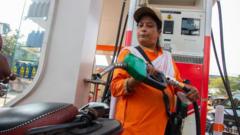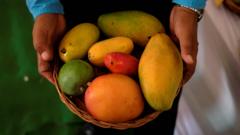India's ambitious biofuel strategy shows progress in carbon reduction, but the trade-off with food resources and vehicle performance raises alarm.
**India's Biofuel Initiative: Balancing Environmental Gains and Economic Concerns**

**India's Biofuel Initiative: Balancing Environmental Gains and Economic Concerns**
India's rapid ethanol blending in petrol raises important questions on food security and vehicle efficiency.
India's commitment to increasing its ethanol blending with petrol has led to significant reductions in carbon emissions while also saving billions in foreign exchange. The government achieved its target of blending 20% ethanol with petrol (E20) well ahead of schedule, claiming a reduction of 69.8 million tonnes of carbon dioxide emissions and fiscal savings of approximately 1.36 trillion rupees (around $1.5 billion) since 2014. Industry experts view this as a critical step in decreasing oil dependence and combating climate change. Yet, vehicle owners and food policy analysts express serious apprehensions about the implications for fuel efficiency and food security.
Despite the government's optimism, a significant portion of the Indian vehicle fleet remains non-compliant with the E20 standards. Concerns about the lower energy density of ethanol, which could diminish mileage and exacerbate wear on vehicle components, have been raised by industry insiders. Notably, editor Hormazd Sorabjee warns of the corrosive nature of E20 on many older models. Although some automakers have begun adapting vehicles for this new fuel blend, the lack of comprehensive compatibility across the market has left many consumers disenchanted.
The federal petroleum ministry has contested these worries, stating that tuning vehicles and investing in E20 compatible materials can mitigate many of the potential downsides. Nevertheless, vehicle insurers indicate that many policies do not cover damages incurred from using non-compliant fuels, complicating matters for consumers. Despite a report from Niti Aayog emphasizing the need for financial incentives to encourage E20 adoption, the government has declined to adjust pricing structures based on the fluctuating costs of ethanol and petrol.
Moreover, the increased demand for ethanol poses significant risks for food security. As it is primarily derived from sugarcane and maize, a shift towards biofuel production could divert crucial food resources. Projections estimate that India would need 10 billion liters of ethanol by 2025, escalating to 20 billion by 2050. Critics, like Devinder Sharma, argue that using food crops for energy could exacerbate hunger in a nation where millions already suffer from food scarcity. The challenge lies in balancing demands for both agriculture and rising energy needs, with an urgent call for sustainable practices.
Amid these challenges, India is not resting on its laurels. Plans to increase blending thresholds beyond E20 are in the works, aiming for E25, E27, and E30 over the coming years as outlined by Petroleum Minister Hardeep Puri. The road ahead is fraught with complexities, as India navigates its dual commitments to environmental sustainability and food security.
Despite the government's optimism, a significant portion of the Indian vehicle fleet remains non-compliant with the E20 standards. Concerns about the lower energy density of ethanol, which could diminish mileage and exacerbate wear on vehicle components, have been raised by industry insiders. Notably, editor Hormazd Sorabjee warns of the corrosive nature of E20 on many older models. Although some automakers have begun adapting vehicles for this new fuel blend, the lack of comprehensive compatibility across the market has left many consumers disenchanted.
The federal petroleum ministry has contested these worries, stating that tuning vehicles and investing in E20 compatible materials can mitigate many of the potential downsides. Nevertheless, vehicle insurers indicate that many policies do not cover damages incurred from using non-compliant fuels, complicating matters for consumers. Despite a report from Niti Aayog emphasizing the need for financial incentives to encourage E20 adoption, the government has declined to adjust pricing structures based on the fluctuating costs of ethanol and petrol.
Moreover, the increased demand for ethanol poses significant risks for food security. As it is primarily derived from sugarcane and maize, a shift towards biofuel production could divert crucial food resources. Projections estimate that India would need 10 billion liters of ethanol by 2025, escalating to 20 billion by 2050. Critics, like Devinder Sharma, argue that using food crops for energy could exacerbate hunger in a nation where millions already suffer from food scarcity. The challenge lies in balancing demands for both agriculture and rising energy needs, with an urgent call for sustainable practices.
Amid these challenges, India is not resting on its laurels. Plans to increase blending thresholds beyond E20 are in the works, aiming for E25, E27, and E30 over the coming years as outlined by Petroleum Minister Hardeep Puri. The road ahead is fraught with complexities, as India navigates its dual commitments to environmental sustainability and food security.






















